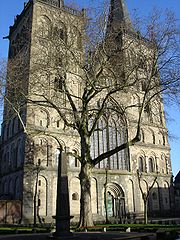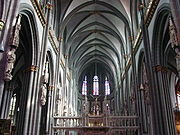
Xanten Cathedral
Encyclopedia

Xanten
Xanten is a historic town in the North Rhine-Westphalia state of Germany, located in the district of Wesel.Xanten is known for the Archaeological Park or archaeological open air museum , its medieval picturesque city centre with Xanten Cathedral and many museums, its large man-made lake for...
, a historic town in the lower Rhine area
Lower Rhine
The Lower Rhine flows from Bonn, Germany, to the North Sea at Hoek van Holland, Netherlands.Almost immediately after entering the Netherlands, the Rhine splits into many branches. The main branch is called the Waal which flows from Nijmegen to meet the river Meuse; after which it is called Merwede...
, North Rhine-Westphalia
North Rhine-Westphalia
North Rhine-Westphalia is the most populous state of Germany, with four of the country's ten largest cities. The state was formed in 1946 as a merger of the northern Rhineland and Westphalia, both formerly part of Prussia. Its capital is Düsseldorf. The state is currently run by a coalition of the...
, Germany
Germany
Germany , officially the Federal Republic of Germany , is a federal parliamentary republic in Europe. The country consists of 16 states while the capital and largest city is Berlin. Germany covers an area of 357,021 km2 and has a largely temperate seasonal climate...
. It is considered the biggest cathedral between Cologne
Cologne
Cologne is Germany's fourth-largest city , and is the largest city both in the Germany Federal State of North Rhine-Westphalia and within the Rhine-Ruhr Metropolitan Area, one of the major European metropolitan areas with more than ten million inhabitants.Cologne is located on both sides of the...
and the sea. In 1936 it was declared a minor basilica
Minor basilica
Minor basilica is a title given to some Roman Catholic churches. By canon law no Catholic church can be honoured with the title of basilica unless by apostolic grant or from immemorial custom....
by Pope Pius XI.
Even though the church is called a cathedral it has never been the seat of a bishop.

Viktor of Xanten
Victor of Xanten or Saint Victor is a martyr and saint of the Catholic and the Eastern Orthodox Church. His presumed bones are kept in a shrine since the 12th century that today is embedded into the high altar of the Xanten Cathedral. His feast day is October 10.Tradition states that Victor was a...
, a member of the Theban Legion
Theban Legion
The Theban Legion figures in Christian hagiography as an entire Roman legion — of "six thousand six hundred and sixty-six men" — who had converted en masse to Christianity and were martyred together, in 286, according to the hagiographies of Saint Maurice, the chief among the Legion's...
who was supposedly executed in the 4th century in the amphitheater of Castra Vetera for refusing to sacrifice to the Roman gods. This Roman camp is near today's town of Birten. According to legend, Helena of Constantinople
Helena of Constantinople
Saint Helena also known as Saint Helen, Helena Augusta or Helena of Constantinople was the consort of Emperor Constantius, and the mother of Emperor Constantine I...
recovered the bones of Victor and his legion and erected a chapel in their honour. During a modern excavation the existence of a 4th-century cella memoriae was discovered; however, it was determined that it had not been erected for Victor but for two other male corpses that were placed in the crypt
Crypt
In architecture, a crypt is a stone chamber or vault beneath the floor of a burial vault possibly containing sarcophagi, coffins or relics....
at a later date.
The cornerstone of the cathedral was laid in 1263 by Friedrich and Konrad von Hochstaden
Konrad von Hochstaden
Konrad von Hochstaden was Archbishop of Cologne from 1238 to 1261.-Life:Konrad was a son of Count Lothar of Hochstadt, canon of St. Maria ad Gradus and of the old Cologne Cathedral, and Mathilde of Vianden. His date of birth is unknown, and nothing is known of his early youth...
. Construction lasted 281 years and was finally finished with the dedication of the Holy Spirit Chapel (German: Heiliger-Geist-Kapelle) in the year 1544. The cathedral contains a five-aisle nave built in the Gothic
Gothic architecture
Gothic architecture is a style of architecture that flourished during the high and late medieval period. It evolved from Romanesque architecture and was succeeded by Renaissance architecture....
style. In contrast to many other cathedrals of the period, St. Victor's lacks an ambulatory
Ambulatory
The ambulatory is the covered passage around a cloister. The term is sometimes applied to the procession way around the east end of a cathedral or large church and behind the high altar....
. Instead a twin pair of chapels is connected to the choir similar to that seen at the Church of Our Lady (German: Liebfrauenkirche) in Trier
Trier
Trier, historically called in English Treves is a city in Germany on the banks of the Moselle. It is the oldest city in Germany, founded in or before 16 BC....
. Along with the monasterial library of the Cathedral houses one of the most important religious libraries of the Lower Rhine
Lower Rhine
The Lower Rhine flows from Bonn, Germany, to the North Sea at Hoek van Holland, Netherlands.Almost immediately after entering the Netherlands, the Rhine splits into many branches. The main branch is called the Waal which flows from Nijmegen to meet the river Meuse; after which it is called Merwede...
. Today the cathedral is the seat of the auxiliary bishop
Auxiliary bishop
An auxiliary bishop, in the Roman Catholic Church, is an additional bishop assigned to a diocese because the diocesan bishop is unable to perform his functions, the diocese is so extensive that it requires more than one bishop to administer, or the diocese is attached to a royal or imperial office...
Heinrich Janssen who presides over the Lower Rhine part of the Diocese of Münster
Roman Catholic Diocese of Münster
The Diocese of Münster is an ecclesiastical territory or diocese of the Roman Catholic Church in Germany. It is a suffragan diocese of the Archdiocese of Cologne. Bishop Felix Genn is the current Bishop of the Diocese of Münster. He was ordained to the priesthood on July 11, 1976 and was appointed...
.
External links
- St. Victor's Cathedral St. Victor's Cathedral - Official site Xantener Dombauverein

